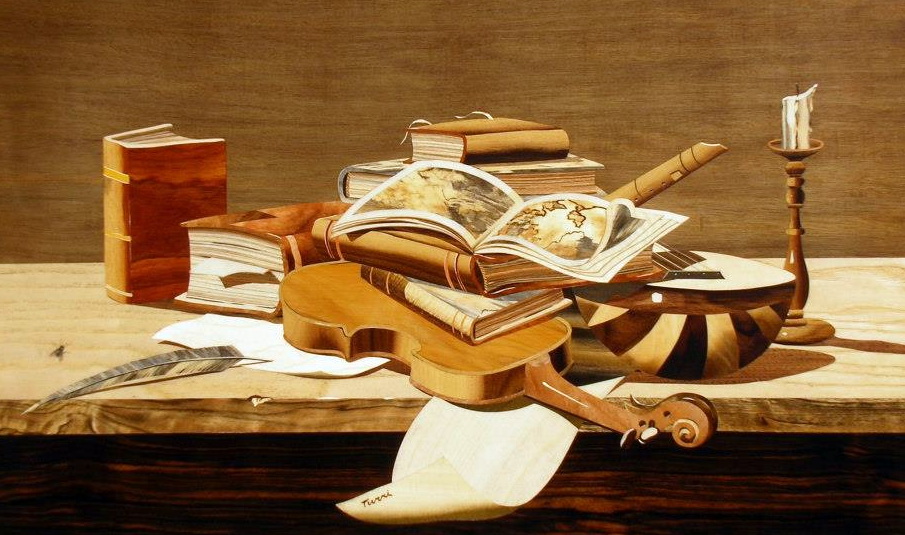While strolling near the top of via Vittorio Emanuele in medieval Anagni, we noticed an advertisement outside a small gallery for an exhibition of wood inlay.
We walked in and saw that the small gallery fronted an old atelier behind and down a few steps from the gallery. The pieces on show around us in the gallery, Tarsie Turri, attracted our attention due to excellent graphics, warm artistic representation, wide range of wood colours and fine finish.
We were welcomed by an elegant lady, Rita, who introduced us to Carlo Turri, her father and the master craftsman of the works.
Everything in this workshop is handmade by Carlo and Rita and they only use the colours of the natural woods they have selected. Every detail, even the smallest, is produced only and exclusively with wood. Rita showed us an inlay of a book in which the edges of over 100 pages were portrayed with slivers of different timbers. The exceptional detail makes this one of the more expensive works on demonstration.
I asked Carlo how they obtained the thousands of ultra-thin sheets of each of the many wood types stored throughout the workshop. He replied that each sheet was created by, in effect, shaving or planing the pieces of wood in their laboratory and as it was approaching lunch time, I was reminded of hand shaving of fine slices of prosciutto.
Carlo said that maybe several slivers were wasted before one good sheet was obtained, one reason being the irregularities in each piece of timber. This may be an issue from a yield viewpoint but it also graces the artist with an infinite array of shades and growth effects in the wood that can make a work of inlay truly unique.
Rita showed how each inlay is created, step by step, meticulously. First of all, the design is created with clear definition of edges of each shape and this is transferred onto a sheet of wood (thickness of ½ mm) that constitutes the base inlay; after which the engraving starts.
A scalpel is used to carefully remove shapes from the base inlay. For each piece, the artist must visualise the effect sought and then select from the thousands of pre-cut slices, one that can meet the expectations.
A piece is cut to create the image sought and then fitted into the gap with extreme care and held in place temporarily with adhesive tape. This one piece having been inserted, the artist repeats the process for maybe hundreds of inlays, each time ensuring there are no gaps and that the pieces match, as if brushed on by a painter.
Carlo showed a large vacuum press that fulfils the job of bonding all the pieces together with a special glue, after which the tape can be removed, and the surface is polished to produce the living effect that their inlay has, evidencing veins and shades in the woods.
The wide range of woods is purchased from around the world, including a variety of eucalypts (gum trees) from the forests of Tasmania. Carlo seeks wood such as wild cherry with a variety of uneven colours to help evidence shade and surface effects in water scenes.
Tarsie Turri has been the love of Carlo Turri for over 40 years, a lone marquetry artisan and artist in this part of Italy. The teaming with his daughter, Rita, is one where the artists have great respect and regard for their art form and achieve joy through their creations.
Scenes of the light and shade in the alleys of Anagni are particularly embracing. Yet the business also caters for those seeking less artistic glory and more stylised marquetry in the form of doors, table tops, frames and panels.
It takes great artistic creativity to be able to harmonize the range of colours offered by nature in timber and this feeling is blended with wonderful technical virtuosity that make the wooden marquetry of the Turris authentic "works of art" of very high quality and exceptional value.
In this small laboratory in the medieval centre of Anagni, Carlo and Rita continue to gain significant international successes, through innovation and renaissance of the art of wood inlay to create a unique aesthetic experience.
Join their admirers who come from around Europe and the far East, and witness the best of wood inlay artistry.







Follow us